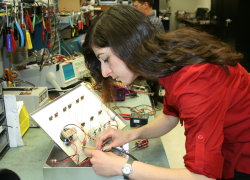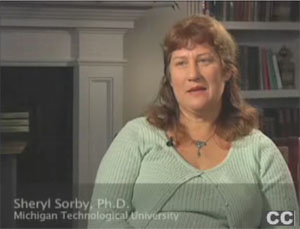 I had the good fortune of seeing the movie Julie and Julia this past weekend and I loved it, as did the rest of the audience! Everyone clapped after many of the scenes—something which rarely happens in the movies. The movie is based on the true stories of the famous, American-French chef Julia Child (played by Meryl Streep) and a New York writer named Julie who decides to cook all of Julia’s recipes in a year and to blog about it daily.
I had the good fortune of seeing the movie Julie and Julia this past weekend and I loved it, as did the rest of the audience! Everyone clapped after many of the scenes—something which rarely happens in the movies. The movie is based on the true stories of the famous, American-French chef Julia Child (played by Meryl Streep) and a New York writer named Julie who decides to cook all of Julia’s recipes in a year and to blog about it daily.
Julia Child broke into the elite and all male French culinary school, Le Cordon Bleu, via sheer persistence. In the movie, Julia watches on her first day as her fellow classmates expertly and rapidly chop onions while she lags behind. The instructor tutors her on proper knife technique, while the others watch and no doubt question her skills. In the next scene we see Julia’s husband come home that evening to find his wife chopping a mound of what must be 30 to 40 onions. The scene is hilarious as they are both crying from all the chopped onions, and the message is clear—Julia is going to do whatever it takes to succeed at Le Cordon Bleu. The very next day in class she chops the onions expertly and is the first to finish, thereby gaining the respect of her fellow male students and instructor.
However, there is one other obstacle to Julia’s success at the Cordon Bleu school of cooking and guess what? It’s a woman, the owner of the school. She is reluctant to let Julia in the school in the first place and sets her up to fail by placing her in an advanced professional class when Julia complains about being in a beginning all female class that is extremely elementary. She refuses to let Julia take the test she needs to receive her diploma. Julia must ultimately reference her friendship with the American Ambassador in order to take the test (her husband is a diplomat). She is given a test clearly designed for her to fail; forcing her to request another opportunity to take the exam.
This touches on a little discussed subject—one that is still relevant today. What about when women undermine other women? Well this does happen, especially when a woman is one of very few. Sometimes the pioneer woman doesn’t want other women to succeed. Why? This phenomenon–referred to as “tokenism” in the field of sociology—happens when someone is a minority and wants to fit in with the majority. Sometimes the way a person tries to accomplish this is by trying to appear more like the majority than the majority group themselves. Clearly it must have been quite rare at that time for a woman to own an elite male culinary school–she must have herself struggled to be in this position–and she did not want to jeopardize this.
An excellent video on tokenism that I have used in the training I do for supervisors on how to integrate women into a male-dominated workplace is The Tale of X and O. The Xs are the insiders and the Os are the outsiders. There are many “ahas” that go off for both men and women when I show it.
Ok, so what did I learn from Julie? I could really relate to her blog launching experience. The first day she gets a comment she’s so excited, only to see it’s from her mom. Weeks go by with no comments and she wonders if anyone other than her mom and her husband read her blog. (Reminds me of me!) The day she gets 10 comments and half of them are from people she doesn’t know, she’s super excited. When her readers start sending her photos, recipes and words of encouragement, she’s in disbelief and ecstatic. Starting a blog is hard! Watching Julie and Julia has inspired me to hang in there and keep posting! Still, if you’re reading this and feel like commenting, please do. I’d love to hear from you and it would really make my day. Thank you for the moral support!
 Recruiting 101: Have you visited the career links section of www.womentechworld.org? There are links to many women in technology and trade associations—some of which have local chapters or an email list that you can access. A few examples of what you can find include Women in GIS, Women in Animation and Women in HVACR .
Recruiting 101: Have you visited the career links section of www.womentechworld.org? There are links to many women in technology and trade associations—some of which have local chapters or an email list that you can access. A few examples of what you can find include Women in GIS, Women in Animation and Women in HVACR .
 Recruiting 101: The key to recruiting women and girls in a field in which they are under-represented is female role models. You already know their numbers are small, so where do you find these women? IWITTS did a survey in 2005 and found that among educators word of mouth was the leading strategy (86%), followed by connecting with women on the street (66%). Respondents also found doing a newspaper story on their program effective! In addition, I’d recommend putting flyers up in your community saying you are looking for female role models in specific occupations.
Recruiting 101: The key to recruiting women and girls in a field in which they are under-represented is female role models. You already know their numbers are small, so where do you find these women? IWITTS did a survey in 2005 and found that among educators word of mouth was the leading strategy (86%), followed by connecting with women on the street (66%). Respondents also found doing a newspaper story on their program effective! In addition, I’d recommend putting flyers up in your community saying you are looking for female role models in specific occupations. I had the good fortune of seeing the movie Julie and Julia this past weekend and I loved it, as did the rest of the audience! Everyone clapped after many of the scenes—something which rarely happens in the movies. The movie is based on the true stories of the famous, American-French chef Julia Child (played by Meryl Streep) and a New York writer named Julie who decides to cook all of Julia’s recipes in a year and to blog about it daily.
I had the good fortune of seeing the movie Julie and Julia this past weekend and I loved it, as did the rest of the audience! Everyone clapped after many of the scenes—something which rarely happens in the movies. The movie is based on the true stories of the famous, American-French chef Julia Child (played by Meryl Streep) and a New York writer named Julie who decides to cook all of Julia’s recipes in a year and to blog about it daily. Have a question on recruiting and retaining women and girls in technology that you want to ask me? Now’s your chance, today I am launching a “Dear Donna” advice column except it will be about gender equity questions. Send your questions to me via
Have a question on recruiting and retaining women and girls in technology that you want to ask me? Now’s your chance, today I am launching a “Dear Donna” advice column except it will be about gender equity questions. Send your questions to me via
 I am happy to see that U Mass’s Computer Science (CS) Department added photos of women to its homepage. Out of seven photos–two now feature women! Unfortunately, the photos of women don’t show them working in the field with equipment as photos 1, 2 and 4 do for the males. The photos now show a woman writing on a board in a classroom setting and two women in an office setting. One of the recommendations IWITTS makes in our WomenTech training is that photos are taken of women working with equipment. Too often women are portrayed in “passive” roles in the workplace while males are in “active” roles.
I am happy to see that U Mass’s Computer Science (CS) Department added photos of women to its homepage. Out of seven photos–two now feature women! Unfortunately, the photos of women don’t show them working in the field with equipment as photos 1, 2 and 4 do for the males. The photos now show a woman writing on a board in a classroom setting and two women in an office setting. One of the recommendations IWITTS makes in our WomenTech training is that photos are taken of women working with equipment. Too often women are portrayed in “passive” roles in the workplace while males are in “active” roles.







Recent Comments